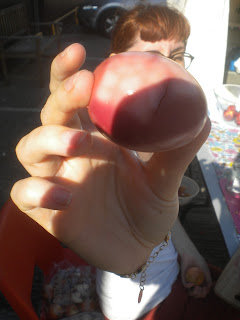I could never say
"Peter Piper picked a peck of pickled peppers;
A peck of pickled peppers Peter Piper picked;
If Peter Piper picked a peck of pickled peppers,
Where's the peck of pickled peppers Peter Piper picked?"
Can you? I could never utter that bizarre combination of words and intertwined sounds of P's, that strange school yard mixture of rhyme and jest that every person possible in the English speaking world (or in the English speaking school yard at least) have overheard and attempted to get there lips and tongue around and through the pickling perplexing saying at some point. It was this long line of P words I was trying to recall as I walked towards G39 for the Roath Feast Pickling event.
As I rounded the corner I was greeted by the sight of a long table cramed full of pickling pots and picked pickling jars in various states of preparation, preservation and in the general pickling process (Yes I am attempting to place and posit every possible P word I can into this pictorial pickling post, which is particularly pleasant).
The concept of "Roath Feast" is rather interesting and refreshingly long in its design. The idea is to run a series of workshops throughout the year, each featuring a different food preparation skill. Sharing and learning new skills and techniques and then at the end of the project to bring these skills together in a community feast.



The first Roath feast workshop themed around that homely and exquisite smelling creation "Bread making". This was followed by the second activity "Pickling". Now I must say I haven't pickled a thing in a very, very long time. What's more I don't know many who has pickled anything or even has self pickled items in their homes. Like a lot of things Pickling is an activity that we, possibly unsurprisingly, seem to be losing. We live in a world of global consumption. The global market of commodities dictate the creation and shipping from far and wide to sit and gather dust on our shelves. Our supermarkets are littered with items from all over the world, picked and harvested a few days before in far flung parts. We enjoy strawberries in winter, oranges, lemons and banana's from distant counties we can't even place on maps and even all year round blooming flowers from the forever sun light filled mass green houses of Holland. The seasonal and dictational factors of nature have been defeated and ignored by the global Capitalist economic system of food consumption.
I had evidence of this many years ago whilst working in a supermarket, one day in the midst of the winter months, when the snow outside was reminiscent of a Dickensian tale, I was told to head down to the frozen fridges and refill the ice.
At first I thought they were joking "fill the ice?" I said "there's a snowmen and children having snow ball fights outside the window. The nation has grown to its traditional, panicky, no traveling halt at the sight of a wisp of snow. The camping shop across the street have a big sale sign up saying "now is the winter of our discount tent". The last time I checked we are in Pontypridd not ice filled frozen Siberia".
"I know" they replied "the snowy weather conditions outside need no explaining but yet we have run out and have a new delivery in".
"Who the flipping heck buys ice in a blizzard? A chap passed me on ski's this morning. Folks in white hoodies are blending into the snow and becoming invisible, if it wasn't for the gold bling around their neck's you'd walk right into them" I implored
"We know its probably the same muppets who are panic buying bread, soup and beans" the reply came.
"Fair enough" I said and went to refill the ice.
The point is we now live in a society that in the partway through winter, in the middle of an unfavourable snow storm, you can still buy a bag of ice from the supermarket. What's more those bags of ice will be refilled and restocked with quite mind blowing efficiency during the day. That shop job proved to me that short of the collapse of western civilisation as we know it by some sort of freak occurrence, nothing is going to stop the supermarket lorry from getting through in the morning with new items for the shelves. We live in a world where food is sadly no longer needed to be stored. For the first time in human history society is now more about waiting for the used by date to expire than about careful planning and saving of foods.
life is more about consumption then preserving which I'm not commenting on as a good or a bad thing but it is a thing. What's more it's something we see in every aspect of society. We now have instant communication, quickening travel around the globe, mass entertainment at a push of a button so why not all year round food too.
I think that's what I like about Roath Feast and its design. The challenge to this consumer culture. The idea of planning and waiting for a meal a year away. The trials and situations this creates will inevitably be a far more interesting experience than just popping to the shops for a pizza (which I do quite a lot to be honest). But the challenge and the idea of planning a meal a year off, I recall a line from Kipling from his fantastic poem "If".
"If you can wait
And not be tired by waiting"
I like the concept of Roath Feast, to wait, and not being tired by it but welcoming and embracing it as part of the experience. It's something I am looking forward to. Best wishes Dai





